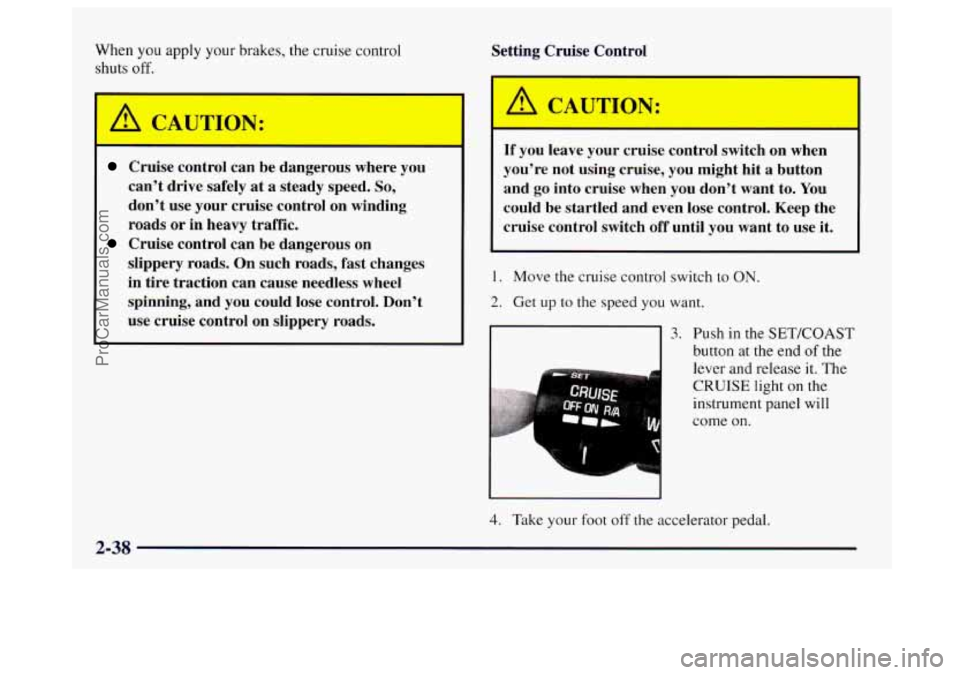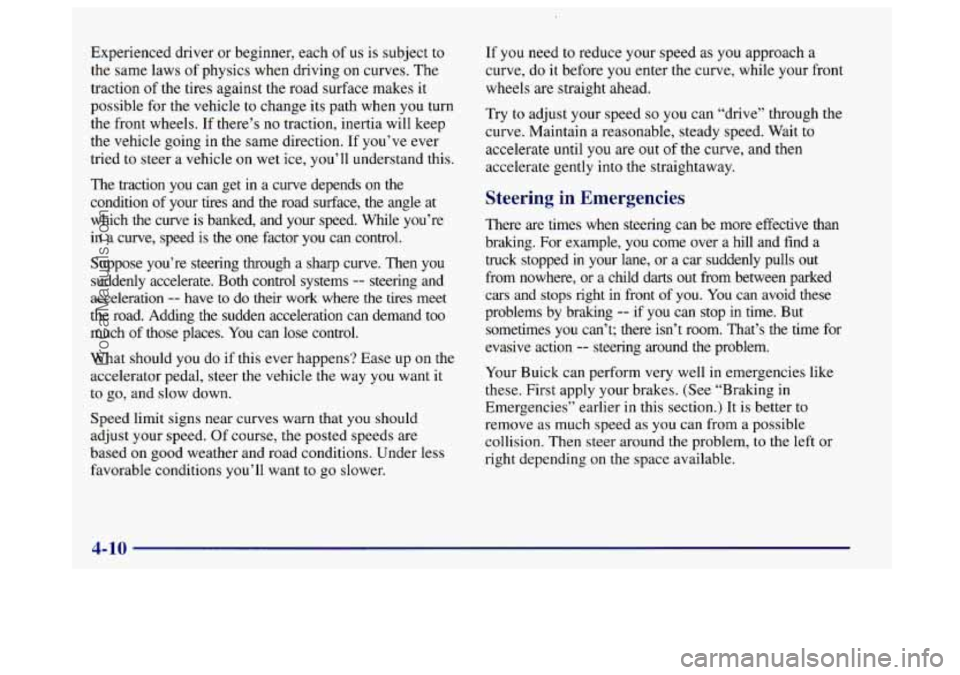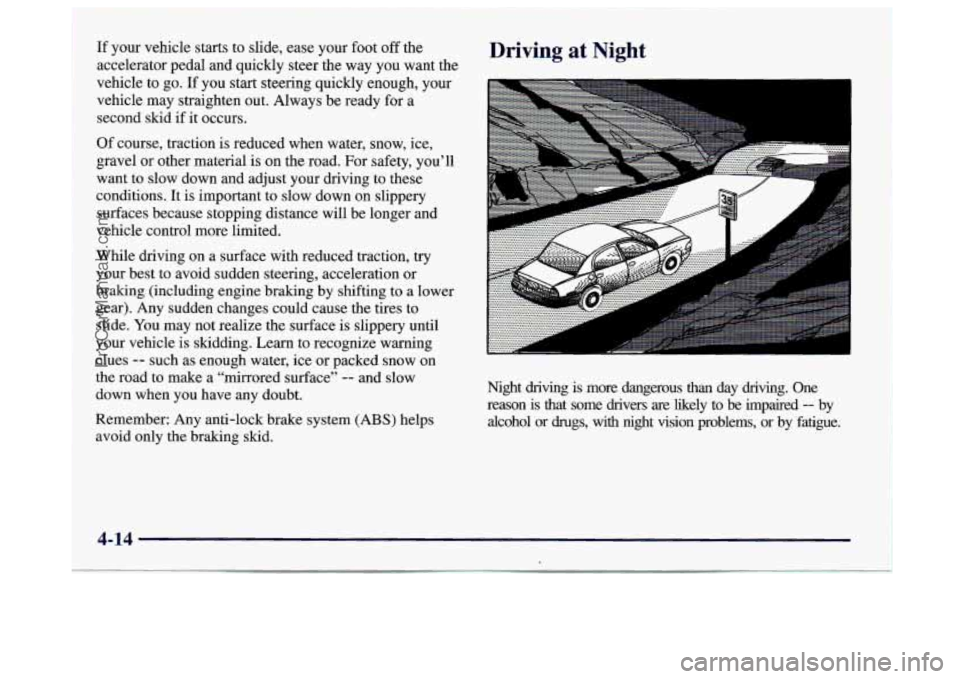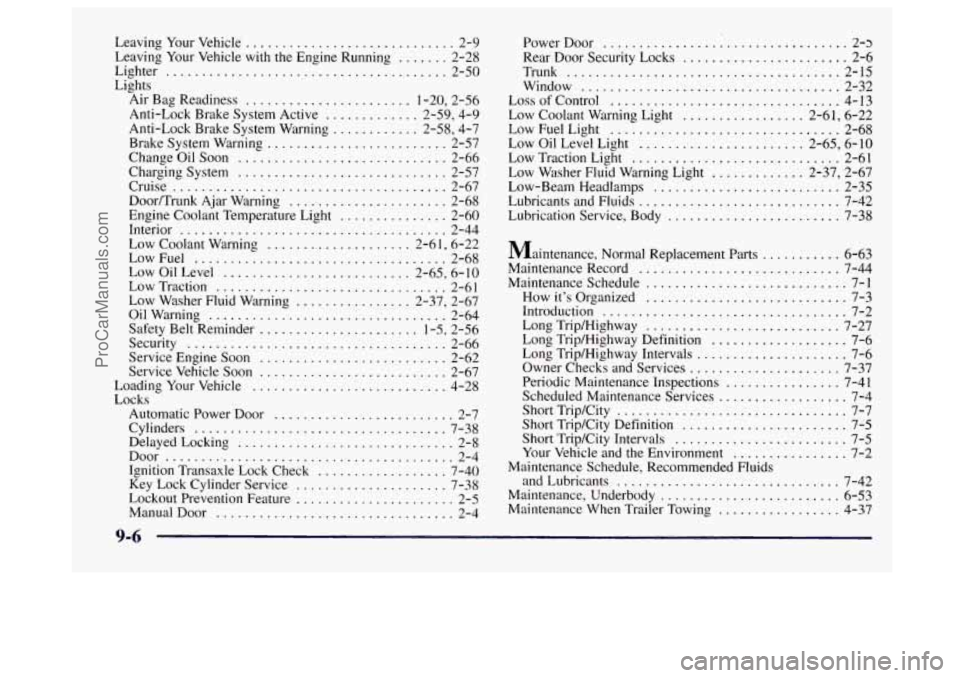1997 BUICK CENTURY traction control
[x] Cancel search: traction controlPage 114 of 406

When you apply your brakes, the cruise control
shuts
off.
/tl CAC LION:
Setting Cruise Control
Cruise control can be dangerous where you
can't
drive safely at a steady speed. So,
don't use your cruise control on winding
roads or in heavy traffic.
slippery roads. On such roads, fast changes
in tire traction can cause needless wheel
spinning,
and you could lose control. Don't
use cruise control on slippery roads.
Cruise control can be dangerous on
A CAUTION:
If you leave your cruise control switch on when
you're not using cruise, you might hit a button
and
go into cruise when you don't want to. You
could
be startled and even lose control. Keep the
cruise control switch
off until you want to use it.
1. Move the cruise control switch to ON.
2. Get up to the speed you want.
3. Push in the SETKOAST
button at the end
of the
lever
and release it. The
CRUISE light on the
instrument panel will
come on.
'1 1
4. Take your foot off the accelerator pedal.
2-38
ProCarManuals.com
Page 196 of 406

Experienced driver or beginner, each of us is subject to
the same laws of physics when driving on curves. The
traction
of the tires against the road surface makes it
possible for the vehicle to change its path when you turn
the front wheels. If there’s no traction, inertia will keep
the vehicle going in the same direction. If you’ve ever
tried to steer
a vehicle on wet ice, you’ll understand this.
The traction you can get in a curve depends on the
condition of your tires and the road surface, the angle at
which the curve is banked, and your speed. While you’re
in a curve, speed is the one factor you can control.
Suppose you’re steering through a sharp curve. Then you
suddenly accelerate. Both control systems
-- steering and
acceleration
-- have to do their work where the tires meet
the road. Adding the sudden acceleration can demand too
much of those places. You can lose control.
What should you do if this ever happens? Ease up
on the
accelerator pedal, steer the vehicle the way you want it
to go, and slow down.
Speed limit signs near curves warn that you should
adjust your speed. Of course, the posted speeds are
based on good weather and road conditions. Under less favorable conditions you’ll want to go slower.
If you need to reduce your speed as you approach a
curve, do it before you enter the curve, while your front
wheels are straight ahead.
Try to adjust your speed
so you can “drive” through the
curve. Maintain
a reasonable, steady speed. Wait to
accelerate until you are out of the curve, and then
accelerate gently into the straightaway.
Steering in Emergencies
There are times when steering can be more effective than
braking. For example, you come over a hill and find a
truck stopped in your lane, or a car suddenly pulls out
from nowhere, or a child darts out from between parked
cars and stops right in front
of you. You can avoid these
problems by braking
-- if you can stop in time. But
sometimes you can’t; there isn’t room. That’s the time \
for
evasive action
-- steering around the problem.
Your Buick can perform very well in emergencies like
these. First apply your brakes. (See “Braking in
Emergencies” earlier in this section.) It is better to
remove as much speed as you can from a possible
collision. Then steer around the problem, to the left
or
right depending on the space available.
4-10
ProCarManuals.com
Page 200 of 406

If your vehicle starts to slide, ease your foot off the
accelerator pedal and quickly steer the way you want the
vehicle to go. If you start steering quickly enough, your
vehicle may straighten out. Always be ready for a
second skid if it occurs.
Of course, traction is reduced when water, snow, ice,
gravel or other material is on the road. For safety, you’ll
want to slow down and adjust your driving
to these
conditions. It is important to slow down on slippery
surfaces because stopping distance will be longer and
vehicle control more limited.
While driving on a surface with reduced traction, try
your best to avoid sudden steering, acceleration or
braking (including engine braking by shifting to a lower
gear). Any sudden changes could cause the tires
to
slide. You may not realize the surface is slippery until
your vehicle is skidding. Learn to recognize warning
clues
-- such as enough water, ice or packed snow on
the road to make a “mirrored surface’’
-- and slow
down when you have any doubt.
Remember: Any anti-lock brake system (ABS) helps
avoid only the braking skid.
Driving at Night
Night driving is more dangerous than day driving. One
reason is that some drivers
are likely to be impaired -- by
alcohol or
drugs, with night vision problems, or by fatigue.
4-14 1
ProCarManuals.com
Page 307 of 406

If you ever replace your tires with those not having a
TPC Spec number, make sure they are the same size,
load range, speed rating and construction type (bias,
bias-belted or radial) as your original tires.
A CAUTJN:
Mixing tires could cause you to lose control while
driving.
If you mix tires of different sizes or types
(radial and bias-belted tires), the vehicle may not
handle properly, and you could have a crash.
Using tires
of different sizes may also cause
damage to your vehicle. Be sure to use the same
size and type tires on all wheels.
It’s all right to drive with your compact spare,
though.
It was developed for use on your vehicle.
Uniform Tire Quality Grading
The following information relates to the system
developed by the United States National Highway
Traffic Safety Administration, which grades tires by
treadwear, traction and temperature performance.
(This
applies only to vehicles sold in the United States.) The
grades are molded on the sidewalls of most passenger
car tires. The Uniform Tire Quality Grading system does
not apply to deep tread, winter-type snow tires,
space-saver or temporary use spare tires, tires with
nominal rim diameters of
10 to 12 inches (25 to 30 cm),
or to some limited-production tires.
While the tires available on General Motors passenger cars and light trucks may vary with respect to these
grades, they must also conform to Federal safety
requirements and additional General Motors Tire Performance Criteria (TPC) standards.
6-41
ProCarManuals.com
Page 308 of 406

Treadwear Temperature -- A, B, C
The treadwear grade is a comparative rating based on
the wear rate of the tire when tested under controlled
conditions on a specified government test course. For
example, a tire graded
150 would wear one and a half
(1
1/2) times as well on the government course as a tire
graded
100. The relative performance of tires depends
upon the actual conditions
of their use, however, and
may depart significantly from the norm due to variations
in driving habits, service practices and differences in
road characteristics and climate.
Traction -- A, B, C
The traction grades, from highest to lowest, are A, B, and
C, and they represent the tire’s ability to stop on wet
pavement as measured under controlled conditions
on
specified government test surfaces of asphalt and concrete.
A tire marked C may have poor traction performance.
Warning: The traction grade assigned to this tire is based
on braking (straight ahead) traction tests and does not
include cornering (turning) traction. The
temperature grades are
A (the highest), B, and C,
representing the tire’s resistance to the generation of
heat and its ability to dissipate heat when tested under
controlled conditions on a specified indoor laboratory
test wheel. Sustained high temperature can cause the
material
of the tire to degenerate and reduce tire life, and
excessive temperature can lead
to sudden tire failure.
The grade
C corresponds to a level of performance
which all passenger car tires must meet under the
Federal Motor Vehicle Safety Standard
No. 109. Grades
B and A represent higher levels of performance on the
laboratory
test wheel than the minimum required by law.
Warning: The temperature grade for this tire is
established for a tire that is properly inflated and not
overloaded. Excessive speed, underinflation, or
excessive loading, either separately or in combination,
can cause heat buildup and possible tire failure.
6-42
ProCarManuals.com
Page 398 of 406

Leaving Your Vehicle ............................. 2-9
Leaving Your Vehicle with the Engine Running
....... 2-28
Lighter
....................................... 2-50
Lights Air Bag Readiness
....................... 1-20’2-56
Anti-Lock Brake System Active
............. 2-59, 4-9
Anti-Lock Brake System Warning
............ 2-58, 4-7
Brake System Warning
......................... 2-57
Change Oil Soon
............................. 2-66
Charging System
............................. 2-57
Door/Trunk Ajar Warning
...................... 2-68
Engine Coolant Temperature Light
............... 2-60
Interior
..................................... 2-44
Low Coolant Warning
.................... 2-61, 6-22
LowFuel
................................... 2-68
Low Oil Level
.......................... 2-65, 6- 10
Low Traction ................................ 2-6 1
Low Washer Fluid Warning ................ 2-37, 2-67
Oilwarning
................................. 2-64
Safety Belt Reminder
...................... 1-5, 2-56
Security
.................................... 2-66
Service Engine Soon
.......................... 2-62
Service Vehicle Soon
.......................... 2-67
Loading Your Vehicle
........................... 4-28
Cylinders
................................... 7-38
Delayed Locking
.............................. 2-8
Cruise
...................................... 2-67
Locks Automatic Power Door
......................... 2-7
Door
........................................ 2-4
Ignition Transaxle Lock Check
.................. 7-40
Key Lock Cylinder Service
..................... 7-38
Lockout Prevention Feature
...................... 2-5
ManualDoor
................................. 2-4 PowerDoor
.................................. 2-3
Rear Door Security Locks ....................... 2-6
Trunk
...................................... 2-15
Window
..................................... 2-32
Loss of Control
................................ 4-13
Low Coolant Warning Light
................. 2-61, 6-22
Low Oil Level Light
....................... 2-65, 6-10
Low Traction Light ............................. 2-61
Low Washer Fluid Warning Light ............. 2-37, 2-67
Low-Beam Headlamps
.......................... 2-35
Lubricants
and Fluids ............................ 7-42
Lubrication Service, Body
........................ 7-38
LowFuelLight
................................ 2-68
Maintenance, Normal Replacement Parts
........... 6-63
Maintenance Record ............................ 7-44
How it’s Organized
............................ 7-3
Long Trip/Highway
........................... 7-27
Long Trip/Highway Definition
................... 7-6
Long Tripmighway Intervals ..................... 7-6
Owner Checks and Services
..................... 7-37
Periodic Maintenance Inspections
................ 7-41
Scheduled Maintenance Services
.................. 7-4
Short Trip/City
................................ 7-7
Short Trip/City Definition
....................... 7-5
Short Trip/City Intervals
........................ 7-5
Your Vehicle and the Environment
................ 7-2
and Lubricants ............................... 7-42
Maintenance, Underbody
......................... 6-53
Maintenance When Trailer Towing
................. 4-37
Maintenance Schedule
............................ 7-1
Introduction
.................................. 7-2
Maintenance Schedule, Recommended Fluids
9-6
ProCarManuals.com
Page 402 of 406

Tail/Stop/Turn Signal Lamp Bulb Replacement ...... 6-33
TapePlayerCare
............................... 3-35
Temperature Control
............. 3-2, 3-4, 3-5, 3-7, 3-8
Theft ......................................... 2-15
Theft-Deterrent Feature .......................... 3-3 I
Theft-Deterrent System .......................... 2- I6
THEFTLOCK TM ................................ 3-3 I
Thermostat .................................... 6-23
Third Gear, Automatic Transaxle
................... 2-24
Tilt Steering Wheel
............................. 2-33
Time, Setting the
............................... 3-12
Tire-Loading Information Label
................... 4-28
Buylng New
................................. 6-40
Changing
a Flat .............................. 5-25
Cleaning
.................................... 6-52
Compact Spare
............................... 5-37
Inspection and Rotation
........................ 6-39
Storing the Flat
............................... 5-35
Storing the Spare
............................. 5-36
Temperature
................................. 6-42
Traction
.................................... 6-42
Treadwear
................................... 6-42
Uniform Quality Grading
....................... 6-41
Wear Indicators
.............................. 6-40
Wheel Replacement
........................... 6-43
When It’s Time for New
....................... 6-40
Tires
........................................... -37
Alignment and Balance
........................ 6-43
Chains
..................................... 6-44
Inflation
.................................... 6-38
Inflation Check ............................... 7-37
Loading
.................................... 4-28
Pressure
.................................... 6-38
TopStrap ..................................... 1-50
TorqueLock
................................... 2-29
Torque. Wheel
Nut ......................... 5-34. 6.62
Towing
a Trailer ................................ 4-30
Towing Your Vehicle
............................. 5-9
Trailer BackingUp
................................. 4-35
Brakes
..................................... 4-34
Driving on Grades
............................ 4-36
Driving
with ................................. 4-34
Following Distance
........................... 4-35
If You Decide to Pull A ........................ 4-31
Maintenance When Towing
..................... 4-37
Parking on Hills
.............................. 4-36
Safety Chains
................................ 4-34
Tongue Weight
............................... 4-32
Total Weight on Tires
.......................... 4-33
Hitches
..................................... 4-33
MakingTurns
................................ 4-35
Passing
..................................... 4-35
Towing
..................................... 4-30
Turnsignals
................................. 4-36
Weight
..................................... 4-32
When You Are Ready to Leave After Parking
onaHill
.................................. 4-37
Automatic
................................... 6-17
Transmitters, Remote Keyless Entry ............ 2-9, 2-12
Transportation, Courtesy
.......................... 8-6
Trip, Before Leaving on a Long
.................... 4-21
Trip Odometer
................................. 2-55
Trunk
........................................ 2-14
Trunk Lid Appliaue
Bulb Replacement .............. 6-34
Lock ....................................... 2-15
9-10
ProCarManuals.com